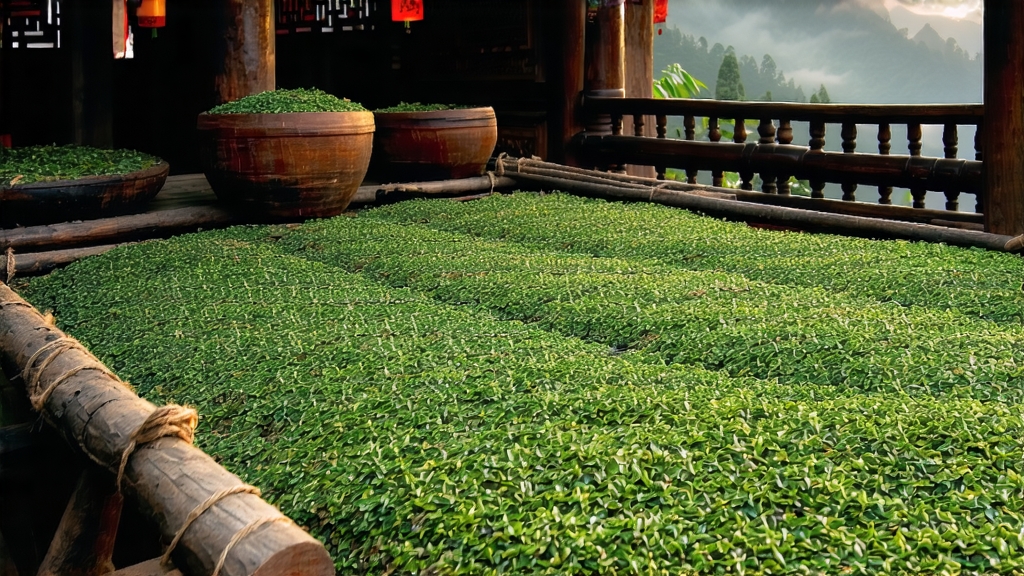
When European tea clippers first rounded the Cape of Good Hope in the late seventeenth century, the fragrant cargo they raced home to London was not the familiar green leaf of Cathay, but a dark, twisted variety that brewed a liquor the color of burgundy and tasted of campfire, dried longan, and the resinous sweetness of Chinese pine. That tea was Lapsang Souchong, today celebrated as the earliest black tea ever created and the prototype for every subsequent red-black infusion from Assam to Ceylon. Its story begins in the precipitous Wuyi Mountains of northern Fujian, where sheer cliffs of volcanic tuff rise above the Nine-Bend River and morning mists linger long enough to perfume the camellia leaves with moisture and minerals. Local legend claims the smoke-drying process was born of military urgency: Qing-era soldiers, so the tale goes, commandeered a tea factory during the harvest of 1646, forcing farmers to hasten leaf-drying over fresh pinewood fires so that the crop could be moved before the army returned. Whether apocryphal or not, the accident became an art, and the art became an industry that would reshape global palates for three centuries.
True Lapsang Souchong is still produced only within the 60 km² core of the Wuyi Nature Reserve, an area known in Minbei dialect as “Zheng Shan” – literally “Original Mountain.” Here, at elevations between 600 and 1,200 m, the small-leaf cultivar Camellia sinensis var. bohea twists its roots into narrow fissures of weathered rock, drawing up potassium and fluoride that concentrate in the tender spring buds. Two distinct styles now leave the mountain: the traditional pine-smoked “Zheng Shan Xiao Zhong,” and its modern, unsmoked counterpart called “Wu Yuan Xiao Zhong,” developed in 2005 to satisfy domestic demand for a sweeter, more floral cup. Both share the same plucking standard—one open leaf together with the adjacent bud—but diverge radically once the freshly carried baskets reach the three-hundred-year-old factory at Tongmu Village.
Craft begins with withering, a twelve-hour ordeal of smoke and breeze. Bamboo trays of leaves rest on multi-tiered racks while pinewood embers smolder beneath the slatted floor; the rising warm air both dehydrates and impregnates the leaf with volatile phenols such as guaiacol and syringol, molecules that later translate into the tea’s signature aroma of smoked apricot. Every twenty minutes the tea master climbs the rack to toss the leaves by hand, judging moisture loss by the change from glossy to matte and by the whispering sound the leaf makes when crumpled. When the leaf has lost 60 % of its weight it is rolled, not by machine but by barefoot treading inside a bamboo drum, a method that bruises the cell walls gently and releases oxidative enzymes without pulverizing the tip. Oxidation follows in cedar-lined chests kept at 26 °C and 85 % humidity; here the leaf reddens from edge to center in exactly ninety minutes, a window so precise that the master sets his sandglass beside the crate and refuses all conversation. Finally comes the decisive smoking-drying phase: the leaf is spread one centimeter thick on wire mesh above a pinewood hearth whose fire has been allowed to die back to glowing coals. A fresh layer of green pine needles is thrown on top; the resulting resinous smoke curls upward for three to five minutes, until the leaf moisture drops to 3 % and the aroma hovers between bacon and lychee. The entire process, from mountain pluck to finished tea, takes less than twenty-four hours, yet demands an ancestral sense of timing no thermometer can replace.
To brew Lapsang Souchong well is to balance its assertive smoke against the natural sugars latent in the bohea cultivar. Western-style infusion works for breakfast service: 2.5 g of leaf per 250 ml of freshly drawn water at 95 °C, steeped four minutes, produces a bright copper liquor that marries effortlessly with milk and honey. Yet the leaf’s true nuance emerges only under gongfu discipline. Begin by pre-heating a thin-walled zisha teapot of 120 ml capacity; the clay’s iron-rich body softens tarry edges without muting the fruit. Rinse 5 g of tightly curled leaf for five seconds to awaken the aromatics, then proceed with successive